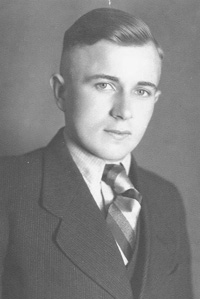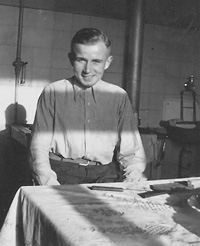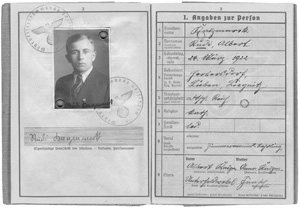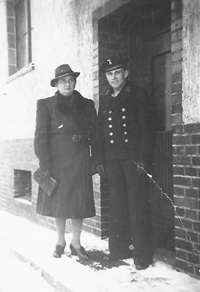|


Germany (1922)
Source:
Renate Vogt (niece) / Schwetzingen
Else Dewitt née Kaczmarek (sister)
|
Rudi Kaczmarek was born on March 24, 1922 in Herbersdorf, Lower Silesia, in the Lüben district, which has a population of 400. He was the first son of Albert Kaczmarek and his wife Anna, née Jänsch. He grew up in the small community with his sister Else, who was one year older. In 1925, another sister, who was baptized Gertrud, followed them. The youngest brother, Hans, was born in 1928. Rudi Kaczmarek discovered his joy in playing soccer with the neighborhood children at an early age. In the summer, everyone frolicked in the village stream, splashed around and built little boats that would float to the sea. In 1928, he started school at the elementary school — which was the only school in the village. According to the stories, he was a good student. At the age of ten he had his first communion, for which a sailor suit with shorts was specially bought. He attended school until 1936 and then began an apprenticeship as a carpenter in his home village.
 The following year, his father Albert was transferred to the town of Glogau, about 20 km to the north, as a professional Wehrmacht soldier. As he felt the time was very uncertain, he took his family with him to Glogau. The house and farm were leased, but the rent was only paid three times. Rudi Kaczmarek, now fifteen years old, changed masters and continued his apprenticeship in Glogau. However, it was only a year before his father's unit was relocated again — this time to Osterode in the Harz Mountains. The small apartment in the attic was replaced by a more spacious apartment on the barracks grounds, which his father was entitled to due to his rank as a sergeant. Rudi Kaczmarek quickly found new friends in Osterode. He fell in love with a female school friend of his younger sister. At the time, Rudi Kaczmarek's girlfriend worked in a gardening business where regular working hours were still a foreign concept. Nevertheless, she visited him and his parents in the barracks as often as she could. The circumstances of the time and the lack of it prevented the two of them from going out dancing even once. Because of the move, Rudi Kaczmarek had to change his master again. He was now gradually approaching the end of his apprenticeship with master carpenter Detlef Schrum and began to think about his future. The following year, his father Albert was transferred to the town of Glogau, about 20 km to the north, as a professional Wehrmacht soldier. As he felt the time was very uncertain, he took his family with him to Glogau. The house and farm were leased, but the rent was only paid three times. Rudi Kaczmarek, now fifteen years old, changed masters and continued his apprenticeship in Glogau. However, it was only a year before his father's unit was relocated again — this time to Osterode in the Harz Mountains. The small apartment in the attic was replaced by a more spacious apartment on the barracks grounds, which his father was entitled to due to his rank as a sergeant. Rudi Kaczmarek quickly found new friends in Osterode. He fell in love with a female school friend of his younger sister. At the time, Rudi Kaczmarek's girlfriend worked in a gardening business where regular working hours were still a foreign concept. Nevertheless, she visited him and his parents in the barracks as often as she could. The circumstances of the time and the lack of it prevented the two of them from going out dancing even once. Because of the move, Rudi Kaczmarek had to change his master again. He was now gradually approaching the end of his apprenticeship with master carpenter Detlef Schrum and began to think about his future.
In 1938 he was initially deferred from work and military service until the end of his apprenticeship, but now his call-up was becoming ever closer. In anticipation of the call-up, he finally volunteered for service in the Wehrmacht in 1939, following his father's example, and was accepted into an army company in Hameln on October 1 of that year, after fulfilling his compulsory work service. After he had sorted this out, Rudi Kaczmarek took his journeyman's examination at the Hildesheim Chamber of Crafts on February 20, 1939. For this he had to complete a journeyman's piece, a work sample, and a theoretical examination. He passed all three areas with a good grade.
 He was called up for the labor service (Reichsarbeitsdienst) on April 1, 1939, so that Rudi Kaczmarek had no opportunity to work as a journeyman carpenter. As a laborer, he was ordered to the labor service Company 7/187 in Braunschweig. Here he was sworn in on April 20 — Adolf Hitler's birthday. As the war approached, the scope of duties of the laborers changed, and they were now increasingly integrated into the Wehrmacht. This was also the case with Rudi Kaczmarek, who, after a brief assignment to Company 2/184, was transferred to the newly formed Light Road Construction Battalion 617 in Badenstedt near Hanover on August 26, 1939. A staff doctor examined him on the same day in Braunschweig to determine that he was "fit for military service." He was sworn in in a hurry the next day, which marked the beginning of his active military service in the army. He temporarily swapped his spade for a rifle. It is very unlikely, however, that his battalion was deployed in the Polish campaign that followed shortly afterwards, as it was a reserve unit. In January 1940, Rudi Kaczmarek was then faced with his long overdue discharge from labor service. Instead, he was briefly transferred to the 11th Construction Replacement Battalion in Zerbst, where he was given a lecture the following day on espionage and how to counter it, treason and maintaining official secrecy, as well as military surveillance, before he was finally able to go home on leave from active service. Back in Osterode, he was again sworn to secrecy by the military registration office.
He was called up for the labor service (Reichsarbeitsdienst) on April 1, 1939, so that Rudi Kaczmarek had no opportunity to work as a journeyman carpenter. As a laborer, he was ordered to the labor service Company 7/187 in Braunschweig. Here he was sworn in on April 20 — Adolf Hitler's birthday. As the war approached, the scope of duties of the laborers changed, and they were now increasingly integrated into the Wehrmacht. This was also the case with Rudi Kaczmarek, who, after a brief assignment to Company 2/184, was transferred to the newly formed Light Road Construction Battalion 617 in Badenstedt near Hanover on August 26, 1939. A staff doctor examined him on the same day in Braunschweig to determine that he was "fit for military service." He was sworn in in a hurry the next day, which marked the beginning of his active military service in the army. He temporarily swapped his spade for a rifle. It is very unlikely, however, that his battalion was deployed in the Polish campaign that followed shortly afterwards, as it was a reserve unit. In January 1940, Rudi Kaczmarek was then faced with his long overdue discharge from labor service. Instead, he was briefly transferred to the 11th Construction Replacement Battalion in Zerbst, where he was given a lecture the following day on espionage and how to counter it, treason and maintaining official secrecy, as well as military surveillance, before he was finally able to go home on leave from active service. Back in Osterode, he was again sworn to secrecy by the military registration office.
 The start of the war had made the planned conscription to Hameln obsolete. Rudi Kaczmarek had changed his mind anyway and volunteered for service in the navy. Whether he wanted to avoid being conscripted into the army because there was a war going on or whether his experiences from his short time in the construction battalion pushed him to make the decision is something we can only guess at today. All we know is that Rudi Kaczmarek loved the sea and the smart navy uniform. His application for enlistment was approved by the 2nd Admiral of the Baltic Sea Station in mid-August 1940. From then on, everything happened very quickly. The start of the war had made the planned conscription to Hameln obsolete. Rudi Kaczmarek had changed his mind anyway and volunteered for service in the navy. Whether he wanted to avoid being conscripted into the army because there was a war going on or whether his experiences from his short time in the construction battalion pushed him to make the decision is something we can only guess at today. All we know is that Rudi Kaczmarek loved the sea and the smart navy uniform. His application for enlistment was approved by the 2nd Admiral of the Baltic Sea Station in mid-August 1940. From then on, everything happened very quickly.
Rudi Kaczmarek stayed barely more than a week after receiving the call-up notice to say goodbye to his parents, siblings and girlfriend before setting off north by train. After arriving in Stralsund, in the 5th Company of the 7th Schiffsstammabteilung, his career in the Navy began with basic training. After just three weeks he went on to the Destroyer Division in Swinemünde for further on-board training. He said little about his training to his family, only that he had really enjoyed Stralsund and Swinemünde. This was obviously out of consideration for his mother, who had been against his joining the Navy from the very beginning out of fear for him. He did not want to cause her any further grief. When he was then assigned to the battleship Bismarck in early January 1941, mother and son were easily reconciled, because this huge ship, as Rudi Kaczmarek told his mother, was considered unsinkable. He also continued to keep in touch with his girlfriend by letter and was already making wedding plans. "He was a lovely darling, reserved and modest and would definitely have been a good husband and father." she reports today.
 Over Christmas 1940, Rudi Kaczmarek spent his only holiday at home with his family. He came home full of pride in his uniform, remembers his brother Hans, who was only twelve at the time. When they said goodbye, immediately after the holidays in Osterode, his mother did not want to let him go, with a dark premonition that she would never see him again. A few months later he sailed out on the Bismarck and was never to return. Rudi Kaczmarek was killed on May 27, 1941, a month after his nineteenth birthday. Over Christmas 1940, Rudi Kaczmarek spent his only holiday at home with his family. He came home full of pride in his uniform, remembers his brother Hans, who was only twelve at the time. When they said goodbye, immediately after the holidays in Osterode, his mother did not want to let him go, with a dark premonition that she would never see him again. A few months later he sailed out on the Bismarck and was never to return. Rudi Kaczmarek was killed on May 27, 1941, a month after his nineteenth birthday.
The family was informed by post about the sinking of the Bismarck and that there might have been survivors about whom no precise information was yet available. This raised the quiet hope that the son was among the survivors. It was not until July 1941 that a letter brought sad certainty: Rudi Kaczmarek was not among the survivors, most of whom were prisoners of war, and was therefore declared missing. This was followed by the posthumous award of the Naval War Badge and thus the "case" was "closed" from the military side. The father learned of his son's death via the field post in Russia. His girlfriend received her own letter back with the note "fallen for Greater Germany". The mother never got over the loss. Her only hope was that he had died quickly, up on the ship and not inside, where terrible things were sure to happen. Her strength slowly waned, and even the return of her seriously ill husband from Soviet captivity in 1948 could not change this. She died in 1951, ten years after her son. The memory of the lovable, modest young man, who was taken from the prime of his life so early, has remained alive in the family to this day.
|
|